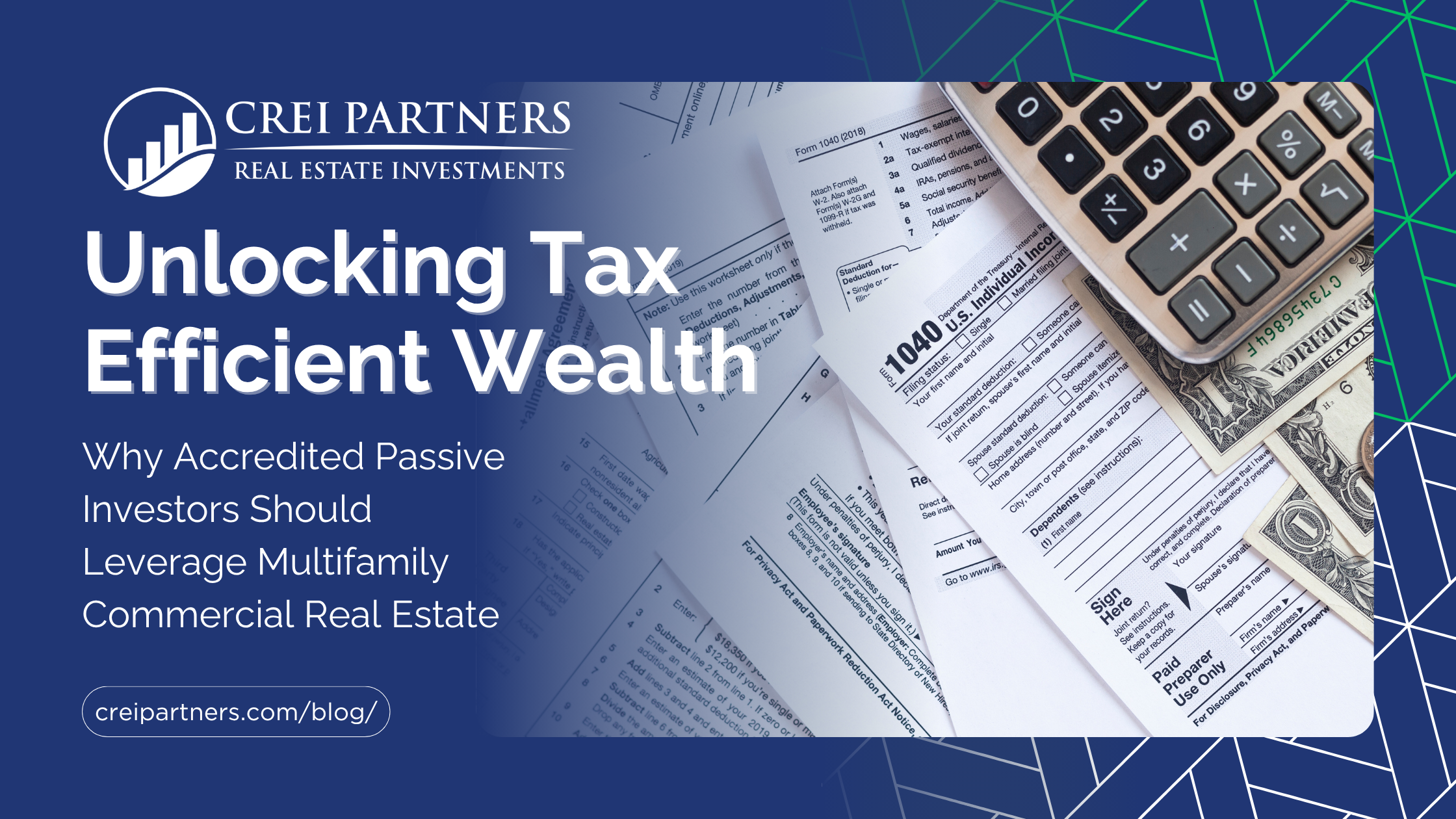As the year draws to a close, accredited passive investors have a unique window to maximize tax benefits while building long-term wealth. Investing in commercial real estate — particularly multifamily assets — remains one of the most powerful ways to combine cash flow, appreciation and tax efficiency. At CREI Partners, we’re focused on structuring opportunities where after-tax returns matter just as much as headline IRRs.
Let’s dive into why the timing matters, what has changed in the tax law, and how you should evaluate opportunities.
1. Why Taxes Should Be Front of Mind Right Now
When you invest in a passive real-estate syndication, you’re not just buying into cash flow and appreciation — you’re participating in a structure that allows you to manage when and how much you pay in taxes. With the end of the year approaching, this is especially relevant because:
- If a deal is placed in service or begins operations before December 31, you may capture deductions in the current tax year, improving your after-tax result sooner rather than later.
- In a market where growth is more modest / less predictable, tax advantages provide a meaningful cushion.
- For accredited investors allocating capital now, aligning investment timing with favorable tax structuring can make a significant difference.
2. What’s Changed: The 100% Bonus Depreciation Law
One of the most important tax changes in 2025 for real-estate investors is the restoration (and in some cases the permanence) of 100% bonus depreciation for qualified property. Key take-aways:
- The recent law known as the One Big Beautiful Bill Act (signed mid-2025) reinstated 100% first-year bonus depreciation for qualifying property acquired after January 19, 2025 and placed in service thereafter. RSM US+4Buchanan Ingersoll & Rooney+4KBKG+4
- For real-estate investors, this means that if the asset qualifies (and is placed in service this year), you may be able to take very large deductions up front via cost segregation + bonus depreciation. Please note: PASSIVE losses offset PASSIVE income. Wipfli+1
- Because the year is winding down, timing matters — for many deals, you’ll want to ensure the structure is in place and the asset is “placed in service” by year-end to capture the deduction in 2025.
- While bonus depreciation is now favorable again, note that older rules (or earlier acquisition dates) may still be subject to the previous phase‐down. Always verify eligibility. KBKG+1
3. Depreciation & Structuring: How the Mechanism Works
Here’s how the benefits work for passive investors in a multifamily syndication:
a) Straight-line Depreciation
- Commercial real estate is generally depreciated over 39 years (residential over 27.5 years).
- This “paper loss” can offset taxable income from the property, reducing your tax burden while the property itself may appreciate.
b) Cost Segregation + Accelerated Depreciation
- A cost segregation study breaks the building into components (fixtures, land improvements, personal property) with shorter lifespans (5, 7, 15 years).
- Combined with 100% bonus depreciation, portions of those assets may be expensed immediately (or in the first year), creating large non-cash deductions.
c) Passive Loss Offset
- As a passive investor, you can use passive losses (from depreciation and other operating deductions) to offset passive income from other investments (subject to IRS rules).
- When structured properly, this means you’re not just investing for returns — you’re investing for tax-efficiency.
4. Why Multifamily Commercial Real Estate is Especially Effective
Passive investors should pay special attention to multifamily structures because:
- Demand resilience: Housing is a basic need; multifamily tends to be more stable than some other commercial asset classes.
- Scale & cost segregation tailwinds: Larger‐scale assets allow more potential for cost segregation, tax structuring, and professional management.
- Professionally-managed, passive role: You don’t run the property — you deploy capital and rely on the operator’s expertise, while they manage the asset, leasing, value‐add, etc.
- Tax strategy synergy: In a time when growth might be moderate, the tax benefits (accelerated depreciation + structuring) help make the deal compelling beyond just rent growth.
5. Timing & Action Steps for Accredited Investors
Given where we are in the year and the tax law environment:
- Act now: If you’re investing this year, make sure the offering and asset will be placed in service (or purchased) in time to capture 2025 deductions.
- Ask the right questions:
- Is a cost segregation study budgeted/commissioned?
- Will the property be placed in service in 2025?
- What is the projected year-one tax deduction vs. cash-flow?
- How conservative are underwriting assumptions (rent growth, exit cap rate)?
- Consider your hold period & exit strategy: Since depreciation recapture is a factor, understand how the operator plans to manage the exit.
- Complement tax strategy with fundamentals: Tax benefits shouldn’t override market fundamentals. Ensure the deal is in a strong market, has good operator track record, and offers durable economics.
6. Key Risks & Mitigations
- Recapture risk: When the asset is sold, depreciation taken may be recaptured and taxed at higher rates — exit planning is critical.
- Passive loss limitations: If you don’t qualify as a “real estate professional,” the ability to offset passive vs. active income is not possible.
- Legislative changes: Tax laws change — while bonus depreciation is favourable now, staying with operators who monitor policy is wise.
- Execution risk: Even with tax benefits, if the property is poorly managed or in a weak market, returns will suffer. Focus on operator alignment and fundamentals.
7. Final Thoughts
As we head into the final quarter of 2025, this is a “now or never” moment for accredited passive investors who want to deploy capital into tax-efficient opportunities. Multifamily commercial real estate deals structured correctly can give you:
- Immediate tax deductions via accelerated depreciation
- Ongoing cash flow from operating performance
- Long-term appreciation and portfolio diversification
- The benefits of passive participation while leveraging operator expertise
If you’d like to explore one of our current offerings (and how you might use tax benefits to your advantage this year), let’s talk.
Disclaimer
CREI Partners, LLC is not a tax, legal, or accounting firm. The information provided in this article is for educational purposes only and should not be construed as professional tax or financial advice. We strongly recommend consulting a certified CPA or qualified tax advisor before making investment decisions or implementing any tax strategies related to your portfolio.


 Subscribe to our newsletter so you never miss out on new investment opportunities, podcasts, blogs, news and events.
Subscribe to our newsletter so you never miss out on new investment opportunities, podcasts, blogs, news and events.